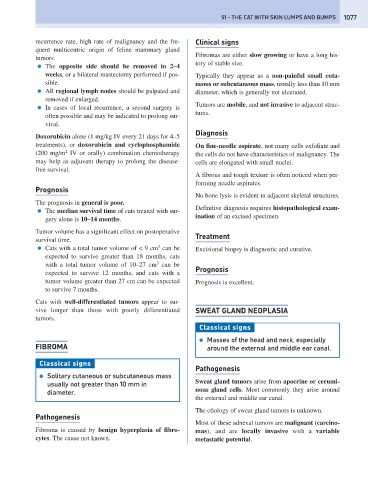Page 1085 - Problem-Based Feline Medicine
P. 1085
51 – THE CAT WITH SKIN LUMPS AND BUMPS 1077
recurrence rate, high rate of malignancy and the fre- Clinical signs
quent multicentric origin of feline mammary gland
Fibromas are either slow growing or have a long his-
tumors.
tory of stable size.
● The opposite side should be removed in 2–4
weeks, or a bilateral mastectomy performed if pos- Typically they appear as a non-painful small cuta-
sible. neous or subcutaneous mass, usually less than 10 mm
● All regional lymph nodes should be palpated and diameter, which is generally not ulcerated.
removed if enlarged.
Tumors are mobile, and not invasive to adjacent struc-
● In cases of local recurrence, a second surgery is
tures.
often possible and may be indicated to prolong sur-
vival.
Diagnosis
Doxorubicin alone (1 mg/kg IV every 21 days for 4–5
treatments), or doxorubicin and cyclophosphamide On fine-needle aspirate, not many cells exfoliate and
2
(200 mg/m IV or orally) combination chemotherapy the cells do not have characteristics of malignancy. The
may help as adjuvant therapy to prolong the disease- cells are elongated with small nuclei.
free survival.
A fibrous and tough texture is often noticed when per-
forming needle aspirates.
Prognosis
No bone lysis is evident in adjacent skeletal structures.
The prognosis in general is poor.
Definitive diagnosis requires histopathological exam-
● The median survival time of cats treated with sur-
ination of an excised specimen.
gery alone is 10–14 months.
Tumor volume has a significant effect on postoperative
Treatment
survival time.
3
● Cats with a total tumor volume of < 9 cm can be Excisional biopsy is diagnostic and curative.
expected to survive greater than 18 months, cats
3
with a total tumor volume of 10–27 cm can be
Prognosis
expected to survive 12 months, and cats with a
tumor volume greater than 27 cm can be expected Prognosis is excellent.
to survive 7 months.
Cats with well-differentiated tumors appear to sur-
vive longer than those with poorly differentiated SWEAT GLAND NEOPLASIA
tumors.
Classical signs
● Masses of the head and neck, especially
FIBROMA around the external and middle ear canal.
Classical signs
Pathogenesis
● Solitary cutaneous or subcutaneous mass
Sweat gland tumors arise from apocrine or cerumi-
usually not greater than 10 mm in
nous gland cells. Most commonly they arise around
diameter.
the external and middle ear canal.
The etiology of sweat gland tumors is unknown.
Pathogenesis
Most of these adnexal tumors are malignant (carcino-
Fibroma is caused by benign hyperplasia of fibro- mas), and are locally invasive with a variable
cytes. The cause not known. metastatic potential.

